August 14, 2020
Air Date: August 14, 2020
FULL SHOW
SEGMENTS

Kamala Harris and Environmental Justice
/ Jenni DoeringView the page for this story
Former Vice President Joe Biden’s choice of Senator Kamala Harris as his running mate made history and highlighted the campaign’s focus on environmental justice. Tiernan Sittenfeld of the League of Conservation Voters joined Living on Earth's Jenni Doering to talk about Senator Harris’s environmental record and the ambition of the Biden--Harris campaign on climate change. (10:30)
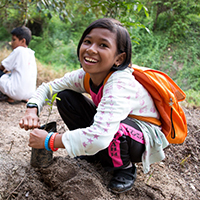
Healthy People Equal Healthy Forests
View the page for this story
Gunung Palung National Park on the island of Borneo is home to diverse species found nowhere else, and beloved by the people who live on the Indonesian island. But like many people who live near tropical forests, they have at times had to resort to illegal logging to pay for healthcare. Now the nonprofit Health in Harmony is providing healthcare that patients can pay for with a simple trade of labor, seedlings or manure, so that no one ever has to log to pay cash for essential health services. Founder Kinari Webb and Host Bobby Bascomb discuss the importance of listening to what forest communities say they need in order to stop logging. (15:10)
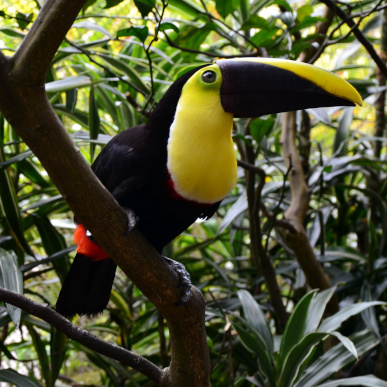
Forests of Rain
/ Mark Seth LenderView the page for this story
In the rainforests of Costa Rica, Living on Earth’s Explorer in Residence Mark Seth Lender encounters a chestnut-mandibled toucan and a scarlet macaw while traveling through the Osa Peninsula. (03:26)
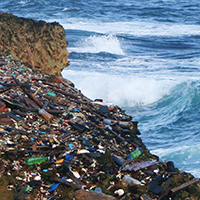
Note on Emerging Science: Plastic-Eating Mushrooms
/ Don LymanView the page for this story
Around 300 million tons of plastic is produced annually, and only a tiny fraction of that plastic is recycled. Since most plastic will take about 400 years to decompose, plastic pollution poses a huge threat to the environment. But, as Living on Earth's Don Lyman explains, the discovery of a mushroom species that feeds on polyurethane might change all that. (01:44)
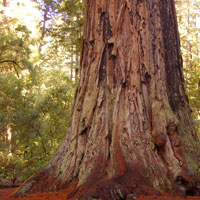
Cloning Giant Sequoias
View the page for this story
The 3000-year-old Giant Sequoia and Coast Redwood trees of the Pacific Northwest are among the biggest and oldest individual living things on our planet. Sadly, all but a few were cut down for logs decades ago. To help restore these majestic trees which sequester large amounts of carbon, the non-profit organization Archangel Ancient Tree Archive has dedicated its efforts to cloning their DNA. David Milarch, co-founder of Archangel Ancient Tree Archive, tells host Bobby Bascomb why cloning specific trees can help restore a resilient population. (09:59)
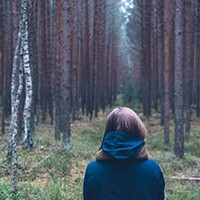
'Forest Bathing' for Health
/ Kara HolsoppleView the page for this story
A walk in the woods might be just what your health provider ordered. Numerous studies suggest that taking in the peaceful atmosphere of a forest can have significant health benefits. Now the practice of “forest bathing,” which originated in Japan in the 1980s as a form of nature therapy, is becoming more popular around the world. From a forested Pittsburgh park, Kara Holsopple reports on this practice for the Allegheny Front. (05:57)
Show Credits and Funders
Show Transcript
HOST: Bobby Bascomb
GUESTS: David Milarch, Tiernan Sittenfeld, Kinari Webb
REPORTERS: Jenni Doering, Kara Holsopple, Mark Seth Lender, Don Lyman
[THEME]
BASCOMB: From PRX – this is Living On Earth.
[THEME]
BASCOMB: I’m Bobby Bascomb.
Joe Biden’s choice of Kamala Harris as his running mate puts a spotlight on environmental justice.
SITTENFELD: We have clear champions who care so deeply about these issues and who get how much the climate crisis is connected to racial injustice, who will do what is in the interests of our environment and our health, and fight for climate justice at every opportunity.
BASCOMB: Also, some of the best trees on earth for quickly soaking up carbon dioxide and mitigating climate change are the giant ancient sequoias.
MILARCH: The beauty of redwoods is they almost refuse to die. You can’t burn them down, they withstand fire. Disease hardly ever attacks them. You can dynamite them, you can cut them down, but they’ll cling to life.
BASCOMB: We’ll have those stories and more this week on Living on Earth – Stick Around!
[NEWSBREAK MUSIC: Boards Of Canada “Zoetrope” from “In A Beautiful Place Out In The Country” (Warp Records 2000)]
[THEME]
Kamala Harris and Environmental Justice

Senator Kamala Harris, a Democrat from California, will be Democratic Presidential Nominee Joe Biden’s running mate in November. (Photo: Gage Skidmore, Flickr, CC BY-SA 2.0)
BASCOMB: From PRX and the Jennifer and Ted Stanley Studios at the University of Massachusetts Boston, this is Living on Earth, I’m Bobby Bascomb in for Steve Curwood.
The Democratic presidential ticket is an historic one, with former Vice President Joe Biden’s choice of Senator Kamala Harris of California as his running mate. Both were among the more moderate candidates during the Democratic primary campaign. But on the issues of climate and environmental justice, Biden-Harris is one of the most progressive presidential tickets this country has ever seen, thanks in part to substantial pressure for climate ambition on the party’s left. The Biden campaign unveiled a $2 trillion climate plan in July, which aims for a carbon-free electric power grid by 2035, among other ambitious goals. And even more recently, Senator Harris introduced two bills focused on environmental justice. Vice president Biden and Senator Harris spoke on August 12 at their first event together as a unified ticket, in Wilmington, Delaware.
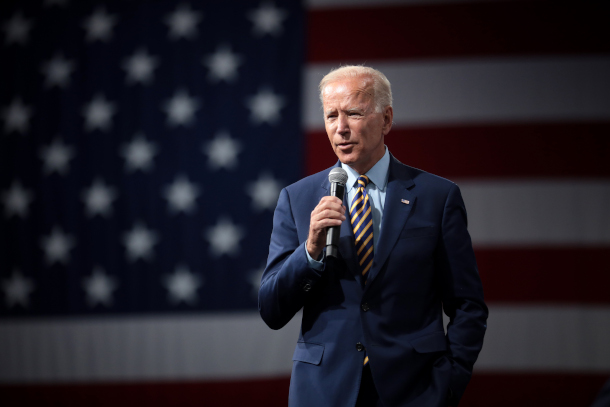
The Biden campaign announced Senator Harris would serve as Joe Biden’s running mate on August 11, 2020. (Photo: Gage Skidmore, Flickr, CC BY-SA 2.0)
BIDEN: As attorney general of the largest state in the country Kamala took on Big Oil, who wanted to pollute without consequences. The Biden--Harris administration is going to meet the climate crisis, protect the health of the American public. Along the way we are going to deliver jobs, good paying jobs.
KAMALA: And that is exactly what we are going to do. We'll create millions of jobs and fight climate change through a clean energy revolution.
DOERING: So Tiernan, at the League of Conservation Voters, you and your colleagues put together an environmental scorecard based on how politicians vote in Congress. Senator Harris's current lifetime score is 91%. And in 2019, she was ranked at 71%. So why did she receive a somewhat low score for that year?
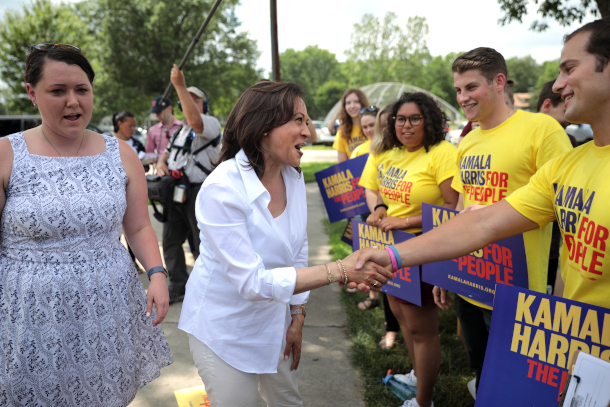
Senator Harris, a former candidate for the Democratic presidential nomination, ran a campaign with attention to environmental issues. (Photo: Gage Skidmore, Flickr, CC BY-SA 2.0)
SITTENFELD: Thank you for asking you about the national environmental scorecard. We are really proud to have been putting that scorecard out for our entire 50 year history. It's considered the gold standard for how members of Congress vote when it comes to the most pressing environmental and public health issues of a session. And Senator Harris received a perfect score of 100%. In 2017 and 2018, her first two years in the Senate, her score dropped because she missed four votes while she was running for president and we are confident that she would have voted pro environment had she been there. And I would also say that when it comes to the environment, and then comes to public health, we have clear champions who care so deeply about these issues and who get how much of the climate crisis is connected to racial injustice. We see how this current administration is ignoring science across the board. They're not listening to the experts yet we contrast that with Vice President Biden, Senator Harris, who are going to trust the experts who believe in science, who will do what is in the interest of our environment and our health and fight for climate justice at every opportunity.
DOERING: So the national conversation around racism and racial disparities in this country right now is focusing attention on environmental justice and the disproportionate exposure of minority communities to air pollution and other environmental concerns. What does Kamala Harris's environmental track record tell us about her environmental justice stance?
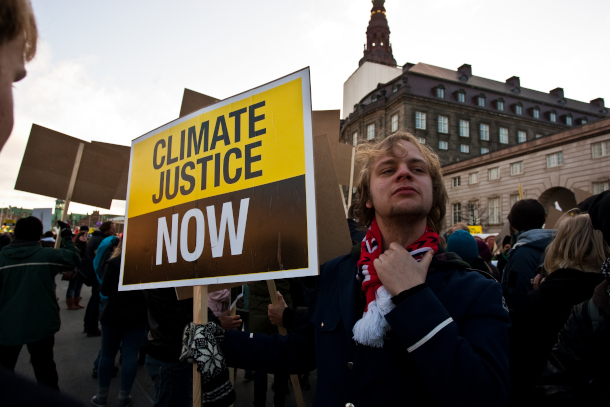
Central to Senator Harris’s environmental action plan during her presidential campaign was a focus on environmental justice issues. (Photo: Magne Hagesæter, Flickr, CC BY-NC-ND 2.0)
SITTENFELD: Senator Harris is extremely focused on environmental justice. She started an environmental justice unit at the San Francisco District Attorney's Office to more aggressively pursue environmental crimes which we know disproportionately impact black, indigenous and people of color. As a US Senator, she's been the leader on the Clean School Buses Act to electrify our nation's school buses. LCV's CHISPA Program has been working for years in communities to push for electric school buses because the diesel pollution from buses has many negative health impacts on our kids and especially on children of color who are even more vulnerable to this. In the Senate she's the lead sponsor of the Climate Equity Act that would give frontline communities and communities of color, a seat at the table and a really important voice from the get-go in policymaking that is centered on environmental justice. She's also very focused on holding both policymakers and polluters accountable. She recently helped introduce the Environmental Justice for All Act which is a landmark comprehensive bill that was developed with input from environmental justice leaders and communities. This was her plan that she put out her climate plan was centered on environmental justice. So I would say it's clear that this is a passion for Senator Harris. And it's also something that has been important to Vice President Biden, he had put out a climate plan that was very strong in June of 2019. He then built on that plan, with additional climate commitments that are more ambitious, and also additional environmental justice commitments. And we know that they care deeply about these issues. They have been listening and learning from environmental justice leaders across the country. And this all comes not a moment too soon, because we are not just talking about some distant threat of the climate crisis. We're talking about toxic pollution in frontline communities and communities of color for decades. And this absolutely has to stop we need to rebuild our economy in a way that is more just and more sustainable. And that really is focused on these frontline communities.
DOERING: A couple of the most controversial issues in the primary campaign where fracking and nuclear energy. What are Senator Kamala Harris's views on these issues?

In early August 2020, Senator Harris (D-CA) and Representative Alexandria Ocasio-Cortez (D-NY) introduced the Climate Equity Act, which would create an Office of Climate and Environmental Justice Accountability and require officials to consider the impacts of environmental legislation on low-income communities. (Photo: Dimitri Rodriguez, Flickr, CC BY 2.0)
SITTENFELD: I think what's important to stress here is that Joe Biden and Kamala Harris have so much in common when it comes to their focus on accelerating our transition to clean renewable energy like wind and solar. And they're basically the opposite of where the Trump administration would take us. When it comes to nuclear energy. We know that Senator Harris opposes storing nuclear waste at Yucca Mountain. She has signed on to a letter with senators Catherine Cortez Masto, to require that the federal government requests Nevada's consent before storing nuclear waste at Yucca Mountain. So we think that's very important. Obviously, the nuclear energy industry has been heavily subsidized and it's at taxpayer expense. So that said, I think that Vice President Biden he does have a place for advanced nuclear in his climate plan. And we believe that she's expressed an openness to a ban on fracking. What we know is that Senator Harris and Vice President Biden share the goal of phasing down the burning of fossil fuels around the world as quickly as as possible, we know that they are rock solid hundred percent committed to addressing the climate crisis and extremely focused on climate solutions. That's why they're talking about them so much on the campaign trail. That's why they're going to lead on them from day one.
DOERING: Tiernan what would you say to voters who were strong supporters of more progressive candidates during the primary like Senator Bernie Sanders, who may not feel that the Biden - Harris campaign is quite ambitious enough on climate environment, other issues? I mean, I've been hearing anecdotally about some young voters actually planning on voting third party because they're just not excited about this ticket.

Senator Harris is the nation’s first Black and South Asian woman to appear on a major U.S. presidential ticket. (Photo: Gage Skidmore, Flickr, CC BY-SA 2.0)
SITTENFELD: For anyone who isn't feeling excited about this ticket. I would encourage them to actually take some time to read through the plans that the Biden campaign has put out to watch some of the speeches. Vice President Biden spoke at an LCV event, the footage is online people can see it and talked about holding fossil fuel companies accountable, talked about restoring our climate leadership. on the world stage, talked about the absolute imperative of addressing environmental injustices that have continued in this country for far too long. From conversations with the Vice President, from conversations with Senator Harris, I know that they care deeply about these issues. I know that they're going to prioritize them, and their leadership could not be in starker contrast with the most anti environment administration we have ever had. The stakes have truly never been higher. So for anyone who's thinking, Oh, it doesn't matter that much, or my vote doesn't matter. I think we have 81 days to go, we need to be all out. I don't think any of us want to wake up on November 4 and feel like if we had only voted if we'd only made some more phone calls to swing voters, or if we'd only send a few more texts like this is it the 2020 elections are absolutely our last best chance to confront the climate crisis and it is going to require all of us being all in to make that happen.
DOERING: So if they're elected this November, what would you need to see from the Biden--Harris presidency to show that they're living up to their promises on climate and environmental justice?
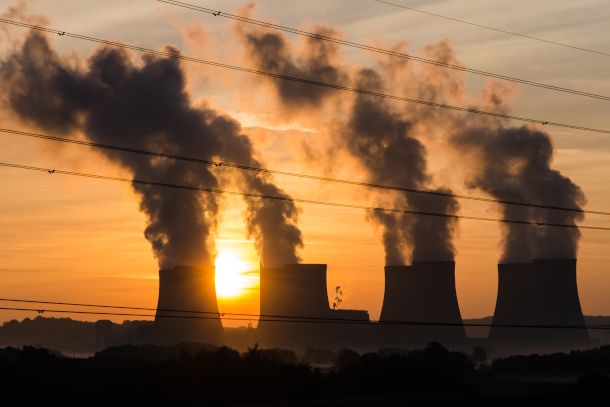
Senator Kamala Harris supports imposing fees for emitting carbon as one way to help curb U.S. carbon emissions. (Photo: Gerry Machen, Flickr, CC BY-ND 2.0)
SITTENFELD: So we expect great things from them when it comes to climate solutions and environmental justice. And there's a lot of both executive actions that they can take on day one. They've both talked about restoring the United States international leadership. Clearly, getting back into the Paris Climate Agreement is just the first step there are more than 100 really atrocious environmental rollbacks that the Trump administration has pursued. Gotta undo all of those, and then really go big when it comes to re-envisioning and rebuilding our economy and putting people back to work. There are so many opportunities to create millions of good union jobs in the clean energy industry, rebuilding roads and bridges and green spaces and water systems. Clearly, the Obama Biden administration made so much progress when it came to making our cars and trucks more efficient. They were incredibly popular standards that were working, that are enabling cars to go further on a gallon of gas. So they're saving consumers money at the gas pump, they're creating jobs, they're good for the planet. Yet Trump inexplicably is working to rollback the clean car standards. There's so much more that we can do in terms of investing in transit and making buildings more efficient. So I think what's clear is that the solutions are there. They're common sense. What we need is the political will and that's why the 2020 elections 81 days from today could not be more important, because we absolutely have to elect environmental and public health champions who are going to look out for the communities across this country who so badly want a clean, safe, healthy environment for themselves, their children and their grandchildren.
BASCOMB: That's Tiernan Sittenfeld, the Senior Vice President of Government Affairs for the League of Conservation Voters, speaking with Living on Earth’s Jenni Doering.
Related links:
- NY Times | Biden and Harris Make First Appearance as Running Mates as Trump and Allies Launch Attacks
- C-SPAN | Joe Biden's Introduction of Senator Kamala Harris as Running Mate
- Learn more about Kamala Harris’s League of Conservation Voters Score Card
- Learn more about Joe Biden’s League of Conservation Voters Score Card
[MUSIC: Bernard Purdy, “Funky Groovy Jam Session” for Drummerworld]
BASCOMB: Coming up – In Borneo doctors are working to keep people healthy as an innovative way to reduce deforestation. That’s just ahead on Living on Earth.
ANNOUNCER: Support for Living on Earth comes from Sailors for the Sea and Oceana. Helping boaters race clean, sail green and protect the seas they love. More information at sailors for the sea dot org.
[MUSIC: Grant Green - "Iron City” from the album Iron City (1967) Cobblestone Records]
Healthy People Equal Healthy Forests
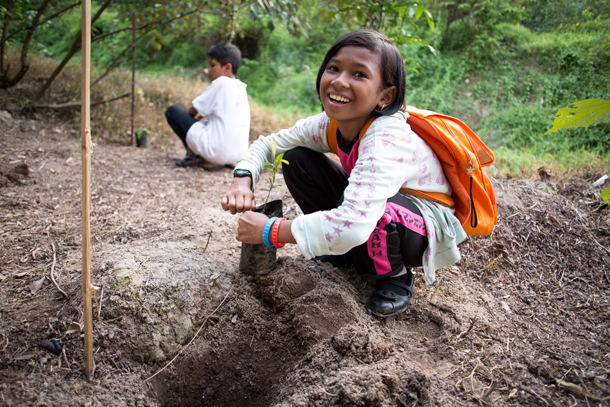
A young girl plants a seedling at the ASRI clinic in Gunung Palung National Park. (Photo: Chelsea Call)
[SFX SOUNDSCAPE FROM BORNEO UNDER LEAD]
BASCOMB: The rainforests of Borneo are some of the oldest tropical forests in world, roughly 130,000 years old. And because they evolved on an isolated island the forests are teeming with endemic species found nowhere else on earth. From highly endangered orangutans, tigers, and rhinos to pygmy elephants just five feet tall. Borneo’s Gunung Palung National Park is a critical habitat for many of the island’s endangered species and a huge carbon sink – crucial in our fight against climate change. The rainforest was also being deforested at an alarming rate when Kinari Webb first visited in the early 90’s. Kinari was a student at the time but she was so alarmed by the deforestation she saw that she went on to found the nonprofit Health in Harmony, which aims to keep the forest healthy by keeping people healthy and she joins me now to explain. Kinari Webb, welcome to Living on Earth!
WEBB: Thank you so much. It is such an honor to be here.
BASCOMB: So first of all, tell me about Gunung Palung National Park in Borneo and the relationship that these communities have with the forest there.
WEBB: So I first went to Borneo when I was an undergraduate. I took a year off and spent a year deep in the rainforest studying orangutans. And Gunung Palung National Park is considered the jewel in the crown of all the Indonesian national parks. It is just the most beautiful place I've ever been on Earth. And what's really interesting is that the communities surrounding the park, there's a lot of people who live right around the park, about 60,000 people. They love the forest as well. They consider it their mother and they understand that their well-being comes from the forest, because, largely because of water, but they also talk about, you know, if you go up into the forest and you log, you push disease down into the communities. And they understand kind of in a spiritual way too, if you log the forest, that might also make you sick just by disturbing the forest herself.
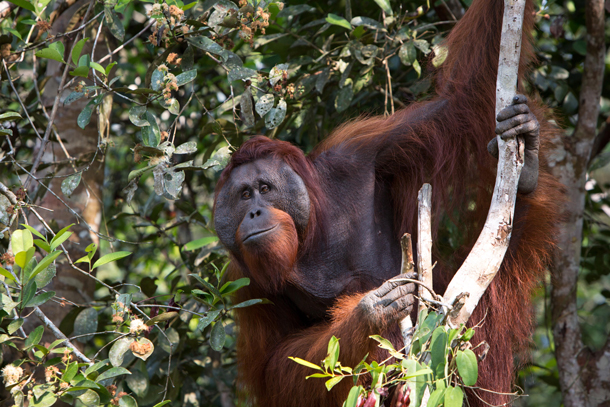
An orangutan in Indonesian Borneo. Kinari Webb was studying orangutans in Borneo in the early 1990s when she found out that much of the logging there was done so locals could cover health care costs. (Photo: Chelsea Call)
BASCOMB: And so how did you come to this idea of providing health care for people as a way to reduce deforestation?
WEBB: So what's really interesting is you look at this situation where the communities really love the forest, they honor and respect it, and they want it to be there for future generations. But the logging was rampant, it was completely out of control. And when I first went there, it was like the forest stretched to the horizon. And then it was just shrinking and you could hear the chainsaws all the time. And at first, I was just so angry at these people. But then I realized, and I talked to many of them, and what they told me was, you know, if my child is sick, or my family member is sick, I have no choice and it's one of the only ways to get cash. At another national park where we recently just started working, one woman told me, if anyone ever tells you that they have not logged to pay for health care, they are lying to you. Because there is no other way to get that much money, and one medical emergency can cost an entire year's income.
BASCOMB: Wow.
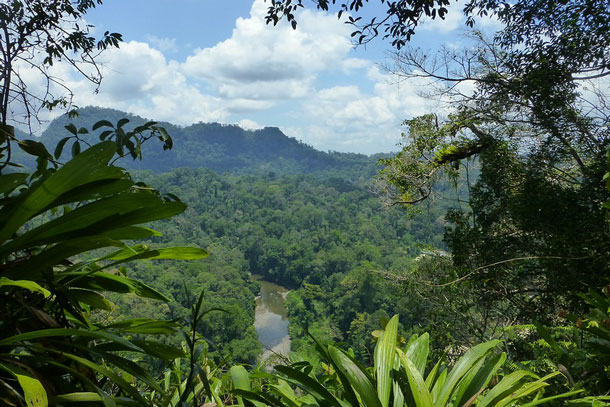
The forests of Indonesian Borneo. (Photo: Andy Nelson, Flickr CC BY-NC 2.0)
WEBB: So that just was like, that just broke my heart. How can that be? And how can we be allowing that to be? So I ended up going to medical school and returning to Indonesia so that I could try to work on this intersection between human and environmental health.
BASCOMB: You call it radical listening, the way that you discovered what these people need and how to help them. Can you tell me more about that?
WEBB: Yeah, you know, it's funny, I call it radical. The reason that I call it radical, even though it's truly just listening, is because we actually do what people say. And that is wildly unusual in the way that development is done and conservation is done. And it's sad that it's unusual, but it is very, very unusual. And so we just sit in a circle with a group of people, you know, about usually about 50 people, something like that. Men and women, leaders and just normal folks from the community. And we ask them, what would you all need as a thank you from the world community so that you could actually protect this precious forest that you all are guardians of? And it was amazing because every single community and everywhere we’ve been, it's been the same, that every community will independently come to a solution that is the same in a given region. So around Gunung Palung it was we need access to healthcare, and we need training and organic farming. And if we have those things, we can stop logging. Now, I just, in the beginning, I just trusted on faith that they truly knew what the solutions were. But 10 years later, we had incredible data that showed a 90% drop in logging households; a stabilization of the loss of primary forest, which had been shrinking like crazy. We had a re-growth, actually, of 52,000 acres of forest, and we had a 67% drop in infant mortality. So this was like this true win-win. And they knew the most efficient and effective ways so that they could do what they wanted to do, which was protect the forest.
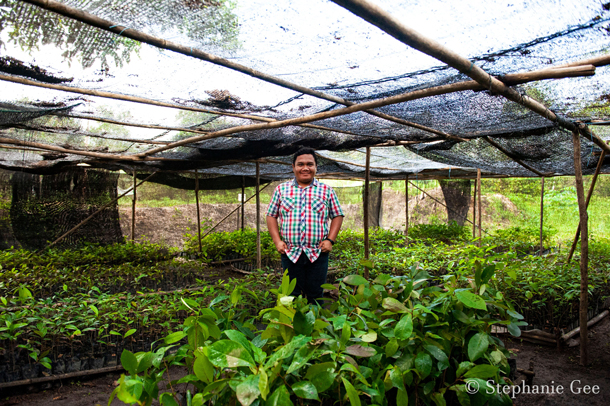
ASRI Director of Conservation Programs Dika stands in a seedling nursery. ASRI is the Indonesian sister nonprofit to Health in Harmony. (Photo: Stephanie Gee)
BASCOMB: It's amazing. I mean, it does ring true to me that, you know, I think a lot of NGOs will go to a community and say, Oh, you need a school, or you need a road. But if you actually stop and ask people, they might say, we need water. We need sanitation. And sounds like that's what you found there.
WEBB: Right? Yeah.
BASCOMB: Well, what kind of healthcare did people have there traditionally, and what does Health in Harmony provide?
WEBB: So when we first started in 2007 in these communities, there was a little government clinic; rarely had a doctor, and the system was not ideal, let's just say. So we ended up starting a little clinic, getting an ambulance, doing mobile clinics. We've now seen over 90,000 patient visits. We ended up providing a kind of simultaneous to the government healthcare system, when the government was struggling to get a system that was quite functional. And since then they have done a much, much better job. And we coordinate with them all the time, and I think that together, we have really made a great difference in these communities. And one of the heads of the Department of Health at one point said to me, he said, You know, I didn't even know it was possible to provide high quality health care in a remote area. It wasn't even trying until I saw your clinic.
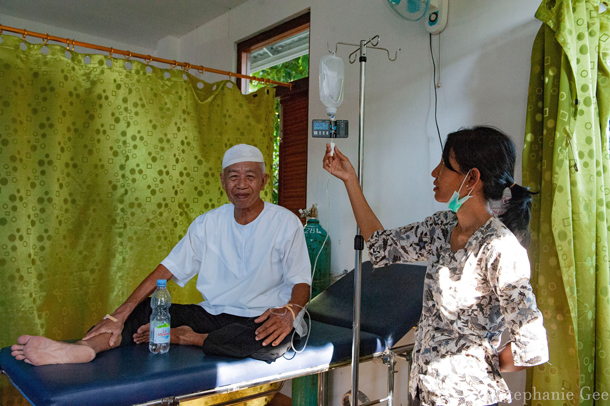
A patient is treated at the medical clinic at ASRI. (Photo: Stephanie Gee)
BASCOMB: And how do you make it affordable for people?
WEBB: So this is, this is sort of where it gets creative. We actually allow people to pay with non-cash payment options. We don't want anyone to ever have to log to pay for health care. So they can pay with seedlings; they can pay with manure, actually, that we use for the organic farming training; they can pay with labor. And these are very popular. Last year, we collected 18,000 seedlings from patients. But we also do another thing, which is that we give community-wide discounts to villages that are based on the amount of logging. So no logging at all, and they get a 70% discount in the clinic. And that discount is paid for by folks from all around the world, people like you, who want to say thank you to them for protecting this precious rainforest that's incredibly valuable to the whole world.
BASCOMB: And I saw your TED talk, you talk about taking American doctors who just want to give back or have an experience working in the developing world, to train your doctors there in Indonesia, or you take experts in agriculture from other parts of Indonesia and bring them to Borneo and do training there on the ground. Can you tell me how those partnerships work?
WEBB: Yeah, so like, I sometimes joke that what is needed in one place in the world just happens to be excess and another place in the world. So the communities needed, you know, and this is what they said, that we need high quality healthcare. So we hired young doctors from Indonesia who had just recently finished medical school, and then we trained them with doctors from the US who would come in free of charge loving this experience, getting to come, see the rainforest, and teaching and of course learning from these young doctors as well. And so that's been very successful. And then when we needed experts in organic farming, the next door island of Java has a many thousand year tradition in sustainable agriculture. So it was easy for us to bring in folks.
BASCOMB: And that's something that people told you that they wanted, was more training in organic farming. Can you tell me about that?
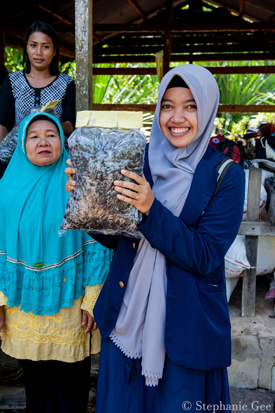
Members of the community are trained in organic and sustainable farming. (Photo: Stephanie Gee)
WEBB: Yeah, it's like so weird, right? I was very, very surprised when people asked for that. I thought, why don't you just talk to your grandparents? But they said no, no, the traditional form of agriculture here is slash and burn, right. And, and so they had some wet rice fields, because they had, they said, look, that system just isn't working anymore, there used to be so much forest and not many people. And it's just not like that anymore. So they said we know that we have to plant in one place, but the only way we know how to do that is with very expensive chemical fertilizers and we just can't afford them. And what was really interesting is that in our five year anniversary party, one of the village chiefs said that many of the former loggers had now become farmers because they didn't need startup money for chemical fertilizers, they could just make their own fertilizer. And, you know, that was one of those sort of like multi layers of why they asked for that solution that, as an outsider I would have never seen.
BASCOMB: And so what were your results? What was the rate of deforestation before you started this program and what is it today?
WEBB: So we started with about 1,350 logging households based on a baseline survey, and then after five years that went down to 450. And then after 10 years, it was down to 150 loggers. That's a 90% drop.
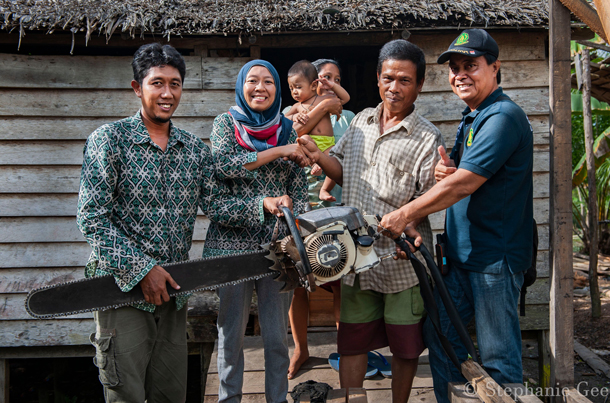
Local Pat Karim sells his chainsaw as part of the Chainsaw Buyback Program, wherein Health In Harmony buys and retires the chainsaws of local loggers and supports them in development of alternate forms of occupation. (Photo: Stephanie Gee)
BASCOMB: Wow.
WEBB: Now, since then, it's actually gone down even more because those last remaining 150 loggers, they are kind of the hardcore folks. They tended to be people who didn't own their own land, which is very unusual in that region. And they tended to own their own chainsaws, which is a huge, huge investment. So we actually started this program called a chainsaw buyback, where it's kind of like angel investing. We give them some money to start a small business, and they also put in money, but the money that they put in is their chainsaw, which we buy from them. And then they started these small businesses, which have been wildly successful. And I think it's mostly because people just didn't have the startup money. I talked to one guy who started a little chicken business, and in his community of 10,000 people, they were actually traveling 45 minutes to the nearest place where you could buy a chicken, right? That's like driving from New Haven to New York City to buy a chicken, that's the closest place you can buy chicken, right. And so I thought, Why has no one ever started a chicken business here before? And then I realized, of course no one has the $800 startup money. So, you know, with a little bit of investment people can start very successful businesses.
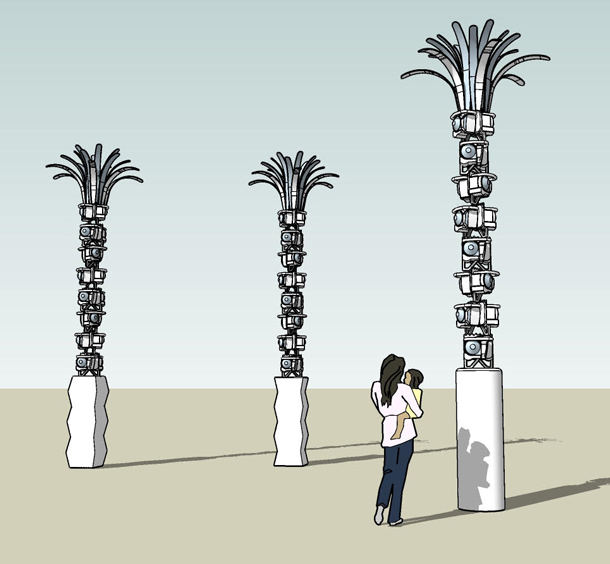
An illustration of what the chainsaw art will look like when completed. (Photo: courtesy of Health in Harmony)
BASCOMB: And what are you doing with all of those chainsaws that you bought?
WEBB: [LAUGHS] Yeah, we're actually, we have an amazing artist who has designed these sculptures, which will look like coconut palms, where we bend the blades, because these blades are very long. These are for cutting down giant, giant rainforest trees. And so we're going to put one in the courtyard of our medical center, and we're going to put one at the national parks office, and we're going to put one at the local university that we partner with, so we're excited about it.
BASCOMB: Oh, that's great. I love it. And what about the health improvements that you've seen?

A baby awaits immunization at the ASRI clinic. Infant mortality in the Gunung Palung area has dropped by nearly 70% since Health in Harmony and ASRI started working there in 2007. (Photo: Stephanie Gee)
WEBB: Yeah, so across the board, people are much, much healthier. You know, one of the very, very common reason for people to come into the clinic in the beginning was malaria. We actually in like the last six years haven't seen a single local case of malaria. We have also seen much less diarrhea, I think there's more than a 50% drop. There was a very interesting paper that came out in Science, I think last year, or the year before, where they looked at forest cover all over the world in relation to diarrhea. And the more forest there is, the less diarrhea.
BASCOMB: Yeah, so keeping the forest healthy, you're also keeping the people healthy. And in lots of different ways, it sounds like.
WEBB: Exactly. So there's like this synergistic effect. One of our Board Chair members, Jo Whitehouse, likes to say, one plus one is 11. I think that's really true. And we've seen all these sort of knock on effects that were totally unexpected, like 42% more children finishing grade school. Now, I'm sure the government had something to do with that. But it's also people are better off, their children are not having to stay home and take care of sick parents. You know, there's just all these ways that, suddenly you can send your kids to school. And that's the first thing you want to do when everything is going better.
BASCOMB: Now, many of our listeners have probably heard about deforestation in Borneo and associate it with palm oil and monocultures, you know, pretty large corporations that are buying these products. To what extent do you see, you know, these large operations impacting the forest where you work there?
WEBB: So there is no question that these large companies are a problem. But what's really interesting, there was an article in Science last year that showed that actually in the tropics, 69% of the loss of carbon is just from degradation, which is to say, taking out trees, individual trees. This is small -- we call it small-scale logging, right, but it's not really small scale. Its enormous. So yes, without question, you know, we should be avoiding palm oil, we should be pressing for more sustainable agricultural techniques from these large companies. But if we are not also addressing the needs of individuals, who really don't want to destroy the forest, they just don't have a choice -- then we're missing the boat. And if we miss the boat on saving rainforests, it's game over. Even if the entire world went to alternative energies, but we lost our rainforests, there's no way that we could deal with climate change.
BASCOMB: Yeah.
WEBB: And we just did a study with Stanford, which was looking at national parks across Indonesia, that's going to come out hopefully soon. And what they found, by looking at satellite imagery, was that while logging was dramatically declining, at Gunung Palung, it was actually increasing in national parks across Indonesia. So you know, we're going to lose these forests. And what's so sad to me is that we're losing them not because the people around them want to destroy the forest. They very much want the forest to be there. They just don't really have a choice.

Kinari Webb. (Photo: Bryan Watt)
BASCOMB: And you're giving them a choice.
WEBB: Exactly. We're asking them what the solutions are, and then saying thank you from the world community.
BASCOMB: Kinari Webb is founder of the nonprofit organization Health in Harmony. Thank you so much for taking this time with me and for all of your good work.
WEBB: Thank you so much as well.
Related links:
- Health in Harmony website
- Dr. Kinari Webb’s TED talk about Health in Harmony
- Paper in Science (2017): Degradation and carbon loss from tropical forests
[MUSIC: Evergreen Studios “Gamelan”]
Forests of Rain
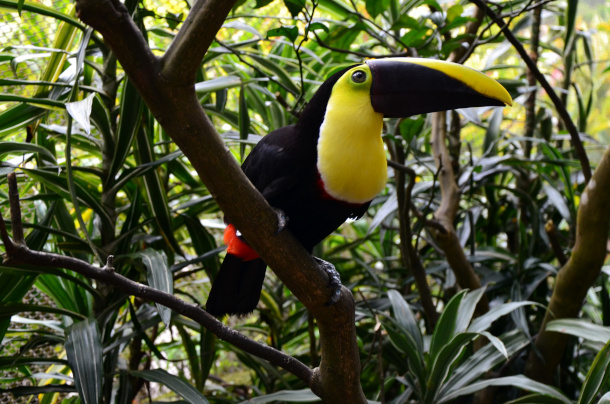
The chestnut-mandibled toucan is often found in lowland forests and close to major bodies of water in Central and South America. (Photo: Tony Fernandez, Flickr, CC BY NC 2.0)
BASCOMB: Rainforests circle the earth like a green belt around the equator. So, from Borneo we take you now to the other side of the planet to a Rainforest in Costa Rica with Living on Earth’s Explorer in Residence Mark Seth Lender.
Forests of Rain
Parque Nacional Corcovado
Costa Rica
© 2020 Mark Seth Lender
All Rights Reserved
On the Osa Peninsula, before the hotels and the money found out, you could walk the edges longer than your drinking water would hold out and never see a human being. It was just Valerie, me, Alonso in the lead pointing out all we would have missed.
“Gavilan Cangrejero,” crab hawk.
“Snake. He imitates, El Fer de Lance.” I bend down -
!No!” Alonso touches my arm. “He might be the real thing.”
That morning at sunrise we woke to Scarlet Macaws, flying rainbows flight after raucous flight. We followed on the beach but they were gone. Now, so is the sun. Under muddy clouds we reach the Madrigal, hardly a trickle of water between the few yards from rainforest on one side, to the Pacific on the other.
Alonso looks up, looks at the river, clicks his tongue. “Si crescenda el Madrigal…”
We cross anyway and continue.
From behind comes a large man with a woven basket. He and Alonso nod. The man looks us over, strides on. “El Pescador,” Alonso says, fisherman. Later we learn what the basket was for: Turtle eggs. Olive Ridley, Hawksbill, Green, all of them nest here. El Pescador has emptied every nest. To him not food but money, he will sell every single one.

The Scarlet Macaw is a parrot from Central and South American that’s most often found in pairs or small family groups. (Photo: David Ellis, Flickr, CC BY NC ND 2.0)
The sky goes black; now, in earnest, rain.
We turn around.
The Madrigal has become the physical translation of crescenda. There are standing waves three feet high in only four vertical feet of water. Enough to sweep a giant off his feet into the crashing sea to drown. Except –
El Pescador has tied a thick line across the river between two trees and left it, for us.
Valerie cannot touch bottom, the current is too strong. Her arms close around my chest and I pull us hand over hand. It takes all I have...
Next morning the sun rises hot and bright as if it forgot. Look, Valerie says. Among tiny purple orchids in the notch of the tree is a Chestnut-mandibled Toucan. High in the canopy, howler monkeys call like Buddhist monks chanting deep in the throat and are answered, by distant thunder.
RAAAAAHHHHHhhhhhhh...
BASCOMB: That’s Living on Earth’s Explorer in Residence, Mark Seth Lender.
Related links:
- Learn more about Mark Seth Lender
- About Destination Wildlife
[MUSIC: Dan Zanes & Friends “El Pescadro” on ¡Nueva York!]
BASCOMB: Coming up – The ancient Japanese tradition of forest bathing. That’s just ahead on Living on Earth.
ANNOUNCER: Funding for Living on Earth comes from you, our listeners, and United Technologies, combining passion for science with engineering to create solutions designed for sustainability in aerospace, building industries, and food refrigeration.
[CUTAWAY MUSIC: Medeski, Scofield, Martin & Wood’s “North London” on Juice]
Note on Emerging Science: Plastic-Eating Mushrooms
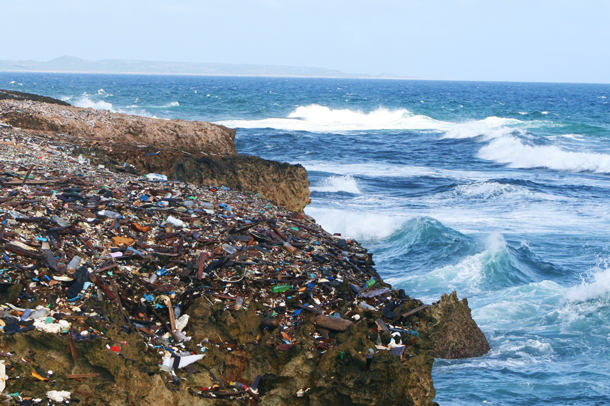
Every year, approximately 300 million tons of plastic is produced around the world. Very little of it is recycled, leaving a large majority to end up as plastic pollution in nature. (Photo: Bastian, Flickr, CC BY-NC-ND 2.0)
BASCOMB: It’s Living on Earth I’m Bobby Bascomb. Just ahead, forest bathing but first this note on emerging science from Don Lyman.
[SCIENCE NOTE THEME]
LYMAN: Worldwide approximately 300 million tons of plastic is produced annually, but only a tiny percent of that plastic is recycled. Now researchers have discovered something unexpected that might help deal with discarded plastic - mushrooms. Researchers from Yale University discovered a species of mushroom Pestalotiopsis microspora in the Amazon rainforest that is able to feed on polyurethane a key ingredient in many plastics. Scientists estimate that most plastic will take about 400 years to decompose on its own. But in controlled experiments, mushrooms were able to break down plastic in just a few months, safely converting it into organic matter or compost. Another study by a researcher at Utrecht University in the Netherlands found several other species of mushrooms that can consume plastic, including common edible species, like the oyster mushroom. If the mushrooms are proven safe to eat after they've broken down the plastic, they may have the additional benefit of providing a food source for people. The initial results are promising but the question of scale remains. The mushrooms in the experiments took several months to degrade a relatively small amount of plastic. Can plastic eating mushrooms keep up with global plastic production? And is there a way to process bigger batches of plastic? Researchers are working on addressing these issues as they continue to experiment with an interesting new way of recycling plastic waste. That's this week's note on emerging science. I'm Don Lyman.
Related links:
- Smithsonian Magazine | “Chow Down on a Plastic-Eating Fungus”
- Click here to read a story on the biodegradation of polyurethane by this fungus
[SCIENCE NOTE THEME]
Cloning Giant Sequoias
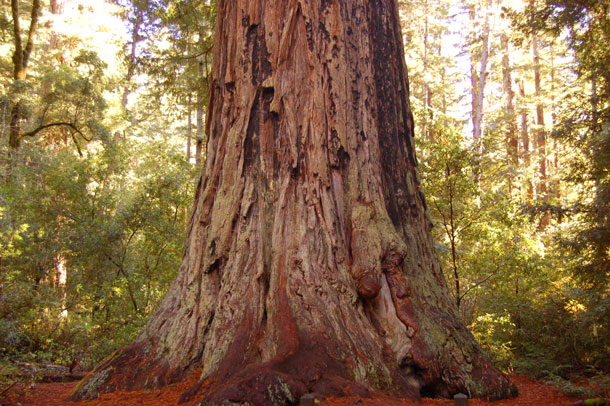
Photo of a Sequoia sempervirens trunk. (Photo: Flickr, CC BY-NC-ND 2.0)
BASCOMB: Around 3,000 years ago the Mayans were just getting started with their temples, Rome was still rural farmland, and it would be another 1000 years ‘til Jesus walked the earth. But also around 3000 years ago in the Pacific Northwest seeds fell and from them grew massive sequoia trees that are still alive today. Giant sequoias and other redwood trees are endemic to the Pacific Northwest and many were standing there long before white settlers came to the region. And when settlers did arrive they found trees more than 30 feet in diameter and hundreds of feet tall, perfect for lumber. Most have been cut down but now researchers have found a way to clone both the living giants as well as some ancient, seemingly dead, trees. Here to explain is David Milarch, co-founder of Archangel Ancient Tree Archive. David, welcome to Living on Earth.
MILARCH: Thanks for having me. It's an honor and a pleasure. It really is.
BASCOMB: So people may have seen old photos of redwood trees. You know, there are 30 or 40 people standing across one and over the top of them. But for someone who's never experienced a living redwood, can you describe redwood trees and what it's like to be in a grove of them?
MILARCH: Well, first and foremost, they're magical. They're enormous. And most people that we've taken to old growth redwood forests, the first thing that everyone has in common is they go completely silent. It's stuns you. They are so huge, up to 400 feet tall, 30 foot wide trunks. And then the next thing most people do is they walk up and they want to put their hand and touch the tree. And as soon as they put their hand up and touch the trees, then they go, wow, this is incredible.
BASCOMB: And what got you started with this project of cloning redwoods? What was the catalyst for that?
MILARCH: 25 years ago, the storm flags were flying on climate change, you know, we've known about climate change since the 60s. And I decided, we had two small children, we needed to find answers to reverse climate change. That's what started this project, finding the answers to reverse climate change.
BASCOMB: And how do redwoods play into that?
MILARCH: Redwoods sequester about 10 times the amount of CO2 that normal trees do. They grew up to 10 feet a year, they grow up to 3-4,000 years old, and they're working 24/7, sequestering CO2 and producing oxygen. And for, like, the Giant Sequoias that we've done, 40% of their dry weight is stored CO2.
BASCOMB: Wow.
MILARCH: So, they're about 1,000 tons apiece. So, 400 tons of that tree is stored excess CO2. That really adds up.
BASCOMB: And what are some of the other trees that you're looking at that are really good at sequestering carbon dioxide?
MILARCH: Giant Sequoia, the Cowrie trees down in New Zealand, Cottonwoods and Aspen's grow very quickly and they're one of our best hopes here in North America for sequestering CO2 on dry and arid land, some of the birches grow very, very quickly. So, it's usually the fastest growing, longest growing, healthiest trees that we're looking for that'll store the greatest amount of CO2. So that's a few.
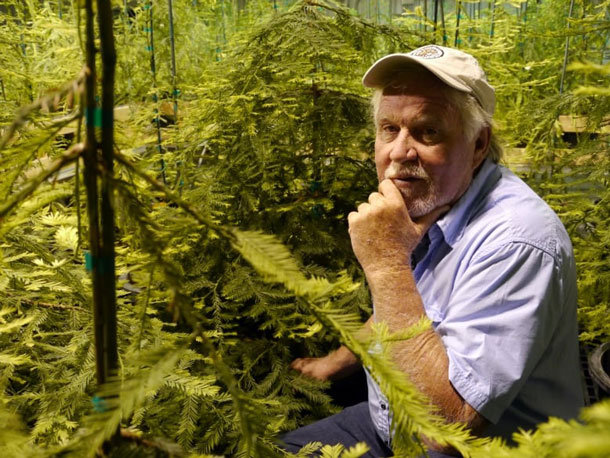
Co-founder David Milarch of Archangel Ancient Trees Archive. (Photo: Courtesy of Archangel Ancient Tree Archive)
BASCOMB: From what I understand the first Redwood fossils date back to about 200 million years ago. But currently they're endangered or at least their populations are in demise. What happened with them? Is it just settlers coming along and cutting them down, or what happened with the redwoods?
MILARCH: It's real simple: man's greed. We have cut down 96% of our old growth redwood forest. For hot tubs, for lumber. And most of it went over across the Pacific. And there's vast quantities of it on the bottom of the ocean in the bays in China, getting ready to be utilized when the price goes up even more. So we've squandered it. We've cut them almost all down in the name of profit. That's before we even realized how great a promise they hold right now when climate change is just really starting to get going. So thank goodness, we decided to try and bring the old growth forests back. When we started 25 years ago, we were almost laughed off the face of the planet. You cannot clone 1,000 year-old, 2,000 year old-trees that we were told. It's like a 115 year old woman trying to have a child. It won't work. We've tried. You're wasting your time. Go back home. That's what we heard from most academics and most forest service people. So we blundered on and we broke through. And I'm happy to say we have cloned 130 different species of trees, all champion trees, the largest and oldest of their species.
BASCOMB: So how do you make a clone of a 3,000 year old Redwood tree?
MILARCH: Well let's begin here. Almost every tree on the planet is self-cloning. What we're doing is just hurrying up the process. We're not changing the DNA at all, we're not doing anything other than nature would do itself. But how we do that is we send climbers to the very tops of these trees, and out to the very ends of the branches. And we found that if we gather this year's new growth, the hormones and chemicals that go through these trees that don't allow them to be cloned haven't gotten there yet. So our climbers bring them down, we rush to a FedEx or somewhere where we can overnight them back to Copemish, Michigan, to our lab. And the very next day we start to work our magic on them, and we're asking them to form roots or to self-clone.
BASCOMB: So the cut down redwoods are they also sending out shoots?
MILARCH: Yes, those are called basal sprouts. But that's a whole different story. One of the trees we worked on were the Coast Redwoods. The coast redwoods have a 500 mile native range from the Oregon-California border, south, down to Big Sur. That's the only range of Coast Redwoods on the planet. Well, we drove and walked that entire 500 mile range. But something different. We look for redwoods, Coast Redwoods on private property.
BASCOMB: Why?
MILARCH: Because the little remnant forests here and there the Coast Redwoods that were saved. When we asked to try to be able to clone those on state and federal land, they said no. So we said. Well, all right, we'll look on a private land. And thank goodness we did. Because the biggest Coast Redwoods and the biggest giant Sequoias are not on state and federal property. They're on private property. One day, my son, Jake Milarch, and I, and Michael Taylor. We were searching for Coast Redwoods and we happened upon a valley. And in this valley behind some people's homes, we found enormous stumps.Trees that were 30 to 35 foot in diameter. Across the top of the stump, a very, very large Coast Redwood was a 20 foot diameter Coast Redwood here we found Coast Redwoods that we're 10 feet or so bigger in diameter than General Sherman, the largest tree on Earth. These were cut down in 1870, and lost. Nobody knew they were there, we stumbled across them. So after I got my composure, and my son walked up to the 35 foot diameter stump, he said, hey, Dad, we should try and clone these. I said, well, Jake, we're pretty good, but these have been cut down for 100 years. He goes, yep, but there's still life in 'em. Let's try.

Sequoia sempervirens seedlings post cloning methods. (Photo: Courtesy of Archangel Ancient Tree Archive)
BASCOMB: So how do you make a clone of a dead tree, though? I mean, there's some life in it, he said. But where does that life come from?
MILARCH: Well, the beauty of redwoods is that they almost refuse to die. You can't burn them down. They withstand stand fire. Disease hardly ever attacks them. You can dynamite them, you can cut them down, but they'll cling to life and they know that on their way out, the mother tree, when she is attacked, and it's life threatening, she'll send up what's called basal sprouts. So out of her trunk, or out of the root system, she'll send up basal sprouts and she'll self clone herself. So we found the basal sprouts, my son did, we took living tissue of that, sent it back to the lab. And I'm happy to say that we have found five different stumps, 30 feet in diameter, across the top, and larger that we've now made thousands of clones. Those trees live on now in seven countries.
BASCOMB: Now, how old are those trees? If they're that much bigger than the other trees, you're saying, how old are they? And and if you could maybe put that into context. I mean, what was happening in the world when these trees were just sprouting and getting going in life?
MILARCH: Well, the trees of 30 foot diameter the Coast Redwoods was we figured to be 2,500 years old. So when Jesus walked the earth, they're already 500 years old. The giant Sequoias is that we found in the Lost Grove, on the very top of the Sierra Nevada Mountains, they are between 3-4000 years old.
BASCOMB: What are the advantages of cloning these ancient trees as opposed to just growing them from seed?
MILARCH: Most Coast Redwoods don't live to be 1000 years old. The ones we're cloning are 2000, 3000 years old. And nobody knows how they were able to do that. Their DNA has never been studied, but doesn't it make sense to us the biggest, oldest, strongest trees that live two or three times the normal age of their species to put those genetics back into our forests?
BASCOMB: What is the future for your work? I understand that you're working in other countries and you have high aspirations but what are you your goals here?
MILARCH: We plan on working in New Zealand this coming year, and Australia. They're just screaming down there for our trees and for us to come down and help preserve their trees. So we're going to do a fundraiser to get down to New Zealand and do the Cowrie Trees. And Australia has pledged to plant a billion trees, they like to plan a bunch of their native clones, so. And, God willing, the funding will come in and we'll be able to go out around the world this year as we planned and teach a lot of the children and get a lot of this work done.
BASCOMB: What motivates you to do this work?
MILARCH: Going after workable, doable solutions to reverse climate change. I don't want to leave this planet and leave my children and my grandchildren, or the world's children and grandchildren, to have to to go through the nightmares that the scientists are predicting. I can't do that. So as long as I draw breath, I will do everything in my power to avert this so everyone's grandchildren don't have the future that some are looking at. We can do better.
BASCOMB: David Milarch is Co-founder of Archangel Ancient Tree Archive. David, thank you so much for sharing your story with me.
MILARCH: Thanks for having me.
Related links:
- Archangel Tree Archive Website
- Washington Post | “Decoding the Redwoods”
- Huffington Post | “Redwood Trees May Help Battle Climate Change, Study Finds”
[MUSIC: Tony Trischka, “Ocracoke Lullabye” on Great Big World, Rounder Records]
'Forest Bathing' for Health
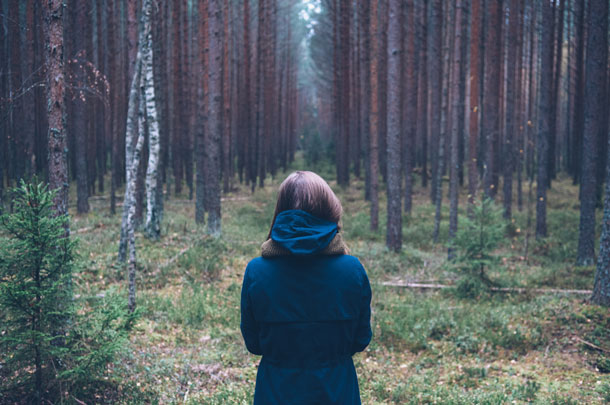
Studies show that 'forest bathing', or shinrin-yoku as it is known in Japan, appears to have health benefits. (Photo: Jordan Sanchez on Unsplash)
BASCOMB: Call it biophilia, love of the outdoors or simply common sense, research shows that spending time in nature can improve human health. In fact, the Japanese have a tradition known as shinrin-yoku or forest bathing, in which practitioners spend meditative time breathing in nature. Allegheny Front reporter, Kara Holsopple, went to Frick Park in Pittsburgh to meet up with Moshe Sherman, a medical Qi Gong therapist who leads regular forest bathing outings.
SHERMAN: The first bathing started in Japan in the 80s as a form of preventative health care. And the idea is that in order to balance the stress of urban life, we need to expose ourselves to nature. And it's very simple. In fact, to just get yourself into nature and be present.
HOLSOPPLE: How is it different than taking a walk or hiking?
SHERMAN: Well, we don't have a destination in mind. And we don't rush just like when we take a bath in hot water, we settle in and relax, we can talk but it's not a time to talk about work like we might do during a walk with a friend or to complain about relationships. It's more time to go inward.
HOLSOPPLE: You're looking up.
SHERMAN: Yes, when we first bathe, we want to look all around and just take it in. So we breathe in the healing energy. We also bring it in through our eyes, we bring it in through our ears, hearing the sounds we bring in through feeling whether it's feeling the weather or touching a leaf. In Japan the term for forest bathing is shinrin-yoku and that literally means to bring in the forest.
HOLSOPPLE: Bring it in to yourself.
SHERMAN: Exactly, in the urban environment we often have to put up what I call energetic shields to protect us. I love cities. I've grown up in the city live in a city my whole life, but I can feel when I come into the forest. It's a chance for those shields to come down.
HOLSOPPLE: Even the muds kind of a soothing sound.
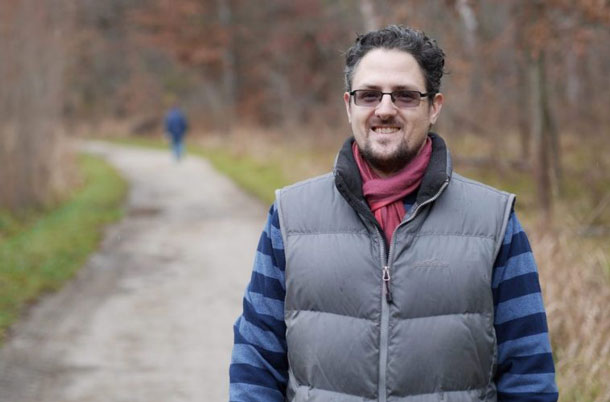
Moshe Sherman is a medical QiGong therapist who leads forest bathing sessions in Pennsylvania parks. (Photo: Kara Holsopple)
SHERMAN: Yes, it is. I was just listening to that as well. Each session is different. There was one session where we did a really fun exercise. We all put our hands on the same tree. And we did a guided meditation where we pretended we were squirrels running up the tree and we got to the top of the tree, looked around and ran back down. And at first I was wondering if anyone was there with me, if it's just me. I got some good feedback afterwards it was a lot of fun.
One of the nice things about forest bathing is it has been widely researched mostly in Asia and also in Europe. And what brought the most recent attention to the United States is a review that was published in summer of 2017 that looked at 64 of those research studies which are all based on empirical evidence, and it really impacts so many systems of the body, cardiovascular system, the respiratory system, and most profoundly, I think, to me right now is how it impacts the immune system. If you do one session of forest bathing for even 20 minutes, we see an increase in what's called the NK cells are the natural killer cells. And these are the cells that protect us from viruses and even from tumor formations.
HOLSOPPLE: Is it just the healing power of nature or something else going on? You know, like, what about being in nature is so good for us?
SHERMAN: There's many levels to it, I don't claim to understand them all. Trees emit something called phytoncides. And these are organic compounds that are released by trees to protect the trees themselves from parasites, disease, and they're actually beneficial for human health as well. So when we're around trees, and we're around plant life, we're breathing those in. I work with Chi or energy, which is a little more abstract, but I think of each tree and each plant as being a unique life form with its own consciousness. And I think when we expose ourselves to a variety of different life forms, it benefits us and I like to think of benefits trees as well, so I think it's a friendship.
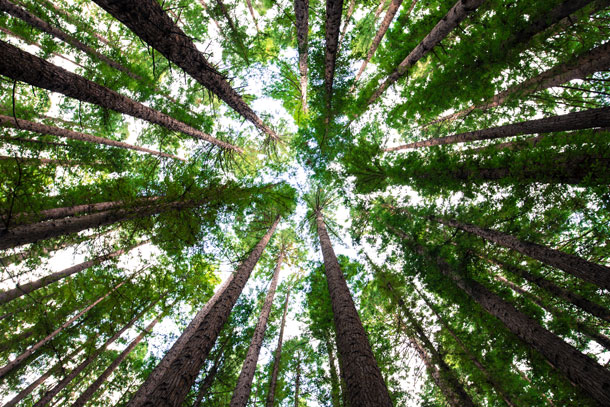
Forest bathing advocates say even just a few minutes in a forest can help change your energy and mood. (Photo: Arnaud Mesureur on Unsplash)
HOLSOPPLE: What do people report to you? What do they say afterwards about the experience?
SHERMAN: Lots of times....
HOLSOPPLE: Does anybody hate it?
SHERMAN: No, I've never had anyone hate, or being unsatisfied, people usually feel more relaxed, more present. And really, when you start to talk to people, you realize that they're processing some heavy stuff that they're going through in their lives, and it helps them with that. People report feeling overall, better is the general feeling you get. I feel great people are chatty, which is always a good sign after a healing session or after a group event, when people feel chatty, it means the energies flowing it means they're feeling uplifted and feeling open to sharing and receiving.
HOLSOPPLE: I'm glad I didn't cancel.
SHERMAN: Me too. Yeah, this is great. You can feel the benefits almost immediately. And then notice how they last they last with you. Lots of times I'll feel them wearing off and that's when I'll get myself back to the park back to the forest. Once you learn how to forest bathe you can do it anytime you don't need a guide although it's more fun when you come do it with a group, but you can do it yourself once you know how to do it. So it's it's like that saying, you know, give a person a fish they eat for a day, teach them how to fish they can eat forever. I think forest bathing is so essential to modern life and creating a balance and health in the modern environment.
CURWOOD: Kara Holsopple’s report comes to us courtesy of The Allegheny Front. And by the way, Moshe Sherman says if you are in a crunch for time, simply sitting under a tree for a while can change your energy and mood.
Related links:
- This story on the Allegheny Front website
- The New York Times | “Take A Walk in the Woods. Doctor’s Orders.”
- A meta-analysis of the potential health benefits of spending time outdoors
- About how phytoncides may promote better health
- Cloud Gate Pittsburgh
[MUSIC: Ahn Trio, “Dies Irie” on Lullaby For My Favorite Insomniac, by Kenji Bunch, Sony BMG Music Entertainment]
BASCOMB: Living on Earth is produced by the World Media Foundation. Our crew includes Naomi Arenberg, Paloma Beltran, Jenni Doering, Jay Feinstein, Anne Flaherty, Don Lyman, Isaac Merson, Aynsley O’Neill, Jake Rego, Kori Suzuki, and Jolanda Omari. Tom Tiger engineered our show. Alison Lirish Dean composed our themes. Special thanks this week to Destination Wildlife. You can hear us anytime at L-O-E dot org, Apple Podcasts and Google Podcasts, and like us, please, on our Facebook page - Living on Earth. We tweet from @livingonearth. And find us on Instagram at livingonearthradio. Steve Curwood is our Executive Producer, I’m Bobby Bascomb. Thanks for listening!
ANNOUNCER: Funding for Living on Earth comes from you, our listeners, and from the University of Massachusetts, Boston, in association with its School for the Environment, developing the next generation of environmental leaders. And from the Grantham Foundation for the protection of the environment, supporting strategic communications and collaboration in solving the world’s most pressing environmental problems.
ANNOUNCER 2: PRX.
Living on Earth wants to hear from you!
Living on Earth
62 Calef Highway, Suite 212
Lee, NH 03861
Telephone: 617-287-4121
E-mail: comments@loe.org
Newsletter [Click here]
Donate to Living on Earth!
Living on Earth is an independent media program and relies entirely on contributions from listeners and institutions supporting public service. Please donate now to preserve an independent environmental voice.
NewsletterLiving on Earth offers a weekly delivery of the show's rundown to your mailbox. Sign up for our newsletter today!
 Sailors For The Sea: Be the change you want to sea.
Sailors For The Sea: Be the change you want to sea.
 The Grantham Foundation for the Protection of the Environment: Committed to protecting and improving the health of the global environment.
The Grantham Foundation for the Protection of the Environment: Committed to protecting and improving the health of the global environment.
 Contribute to Living on Earth and receive, as our gift to you, an archival print of one of Mark Seth Lender's extraordinary wildlife photographs. Follow the link to see Mark's current collection of photographs.
Contribute to Living on Earth and receive, as our gift to you, an archival print of one of Mark Seth Lender's extraordinary wildlife photographs. Follow the link to see Mark's current collection of photographs.
 Buy a signed copy of Mark Seth Lender's book Smeagull the Seagull & support Living on Earth
Buy a signed copy of Mark Seth Lender's book Smeagull the Seagull & support Living on Earth

